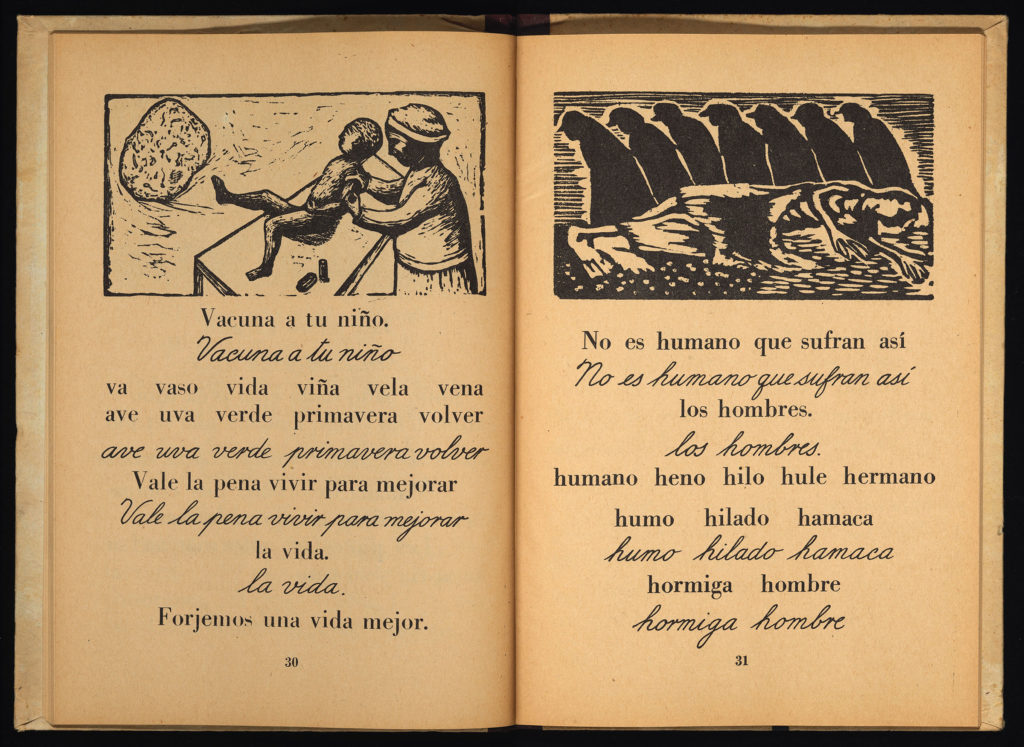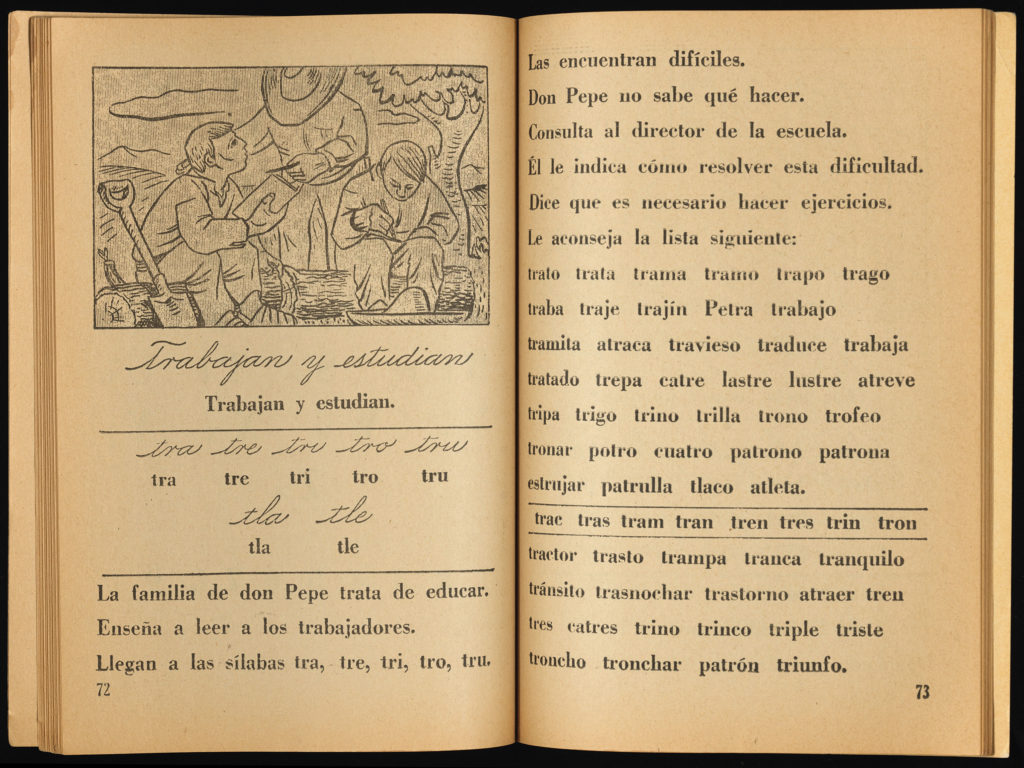by Erika Hosselkus, Curator, Latin American Collections
Earlier this year, Mexico celebrated the 60th anniversary of the creation of its National Free Textbook Commission (Comisión Nacional de Libros de Textos Gratuitos, CONALITEG). This program began in 1959 under the auspices of minister of public education, Jaime Torres Bodet. Today, the commission prints some 200 million free textbooks for more than 25 million Mexican students every year. Mexican administrations continue to tout the duration and scope of this program and scholars highlight it among systematic efforts toward free, secular education that began in earnest in Mexico after the Mexican Revolution (1910-1920).
“Libros de Lectura: Education and Literacy after the Mexican Revolution / Educación y Alfabetismo despues de la Revolución Mexicana”, a spotlight exhibit in Rare Books and Special Collections, highlights our growing collection of textbooks from the first half of the twentieth century in Mexico and examines literacy efforts in the decades before and after the formation of the National Free Textbook Commission. The exhibit showcases literacy-related materials sponsored, approved, or produced by Mexico’s Ministry of Public Education including textbooks for children and books promoting literacy among adults, whether workers or indigenous Popoloca-speakers.
Among the materials on display are Libro de lectura para el uso de las escuelas nocturnas para trabajadores (1938) and Cartilla, Campaña nacional contral el analfabetismo (1965). Both of these titles were produced by Mexico’s Ministry of Public Education.
 Libro de lectura para el uso de las escuelas nocturnas para trabajadores is one in a series of three literacy textbooks created by Mexico’s League of Revolutionary Writers and Artists (LEAR) and was intended for workers enrolled in night classes. It was produced during the presidency of one of the country’s best-known leaders, Lázaro Cárdenas (1934-1940), an era when socialist ideals contributed explicitly to the development of national identity and also became explicit in literacy texts.
Libro de lectura para el uso de las escuelas nocturnas para trabajadores is one in a series of three literacy textbooks created by Mexico’s League of Revolutionary Writers and Artists (LEAR) and was intended for workers enrolled in night classes. It was produced during the presidency of one of the country’s best-known leaders, Lázaro Cárdenas (1934-1940), an era when socialist ideals contributed explicitly to the development of national identity and also became explicit in literacy texts.
The book includes striking unsigned illustrations from prints by known Mexican artists. Heavy woodcut or linocut styles and strong imagery are characteristic of Mexico’s revolutionary art. The text begins by introducing the alphabet, vowels, and basic pronunciation. Later entries address aspects of daily life, familiar socialist themes, and even deliver public service announcements regarding, for example, the need for childhood vaccinations.

Cartilla, Campaña nacional contral el analfabetismo is evidence of a major literacy campaign undertaken by Mexico’s Ministry of Public Education in 1965. The National Free Textbook Commission (CONALITEG) printed an impressive 1,000,000 copies of this literacy primer as part of the nationwide effort. The text is meant to be used by any literate person to teach another person how to read. It provides lessons as well as instructions for use. The teacher is directed never to discourage a learner and instead to make her feel capable and successful. Helping a person learn to read, the primer states, helps to elevate the culture of the Mexican people.
Much like the earlier Libro de lectura para el uso de las escuelas nocturnas para trabajadores, this primer begins with pronunciation exercises and introduces more complex passages, including some clear government messaging, as appears on pp. 72-73 of this title. In this passage, entitled “They work and they study,” the family of Don Pepe works to educate laborers. When they encounter difficulty with part of the literacy text, Don Pepe consults the director of the local school, who tells him that the laborers need to practice a series of exercises to overcome their difficulty. In this way, the text promotes literacy among peasants and workers, facilitated by literate individuals, and offers a solution to challenges that might be encountered in the learning process.

Other titles on display as part of the spotlight exhibit “Libros de Lectura: Education and Literacy after the Mexican Revolution/Educación y Alfabetismo despues de la Revolución Mexicana” are:
Francisco Cuervo Martínez, Mexico: Libro Nacional de Lectura V Año, (Ideologia Revolucionaria), Mexico: Editorial Patria, 1937. Medium PC 4113 .C83 1937
Leopoldo Mendez, En nombre de Cristo…han asesinado mas de 200 maestros. Mexico: Centro Productor de Artes Plasticas del Depto. de Bellas Artes, 1939. XLarge NE 546 .M4 E54 1939
Primer Cartilla Popoloca. Mexico: Instituto Lingüistico de Verano; Dirección General de Asuntos Indígenas de la Secretaría de Educación Pública, 1952. Medium PM 4206 .P67 1952
Carmen Domínguez A. and Enriqueta León G., Mi nuevo amigo, Libro segundo de lectura. Mexico: Empresas Editoriales, 1957. Medium PC 4115 .D59 1957



